Growing up in Bataan, my weekends weren't complete without a trip to Denbell's in Balanga for their legendary bopis. I still remember how the warm, spicy aroma would hit you the moment you walked in, and that satisfying "pulutok" sound from the kitchen would make your mouth water instantly.
While nothing beats those cherished memories of sharing a sizzling plate of bopis with my friends over ice-cold beer and endless kwentuhan, I've finally mastered making this Kapampangan classic at home after years of trial and error. This bopis recipe captures that perfect balance of heat and tang that Denbell's is famous for, where every spoonful of tender, spiced organ meat makes you reach for both more rice and your next beer bottle.
If you've ever been intimidated by cooking bopis or thought it was too complicated to make at home, this recipe breaks it down into simple steps that even beginners can follow. This heritage dish is your gateway to understanding why Kapampangans are considered the country's culinary masters.
Jump to:
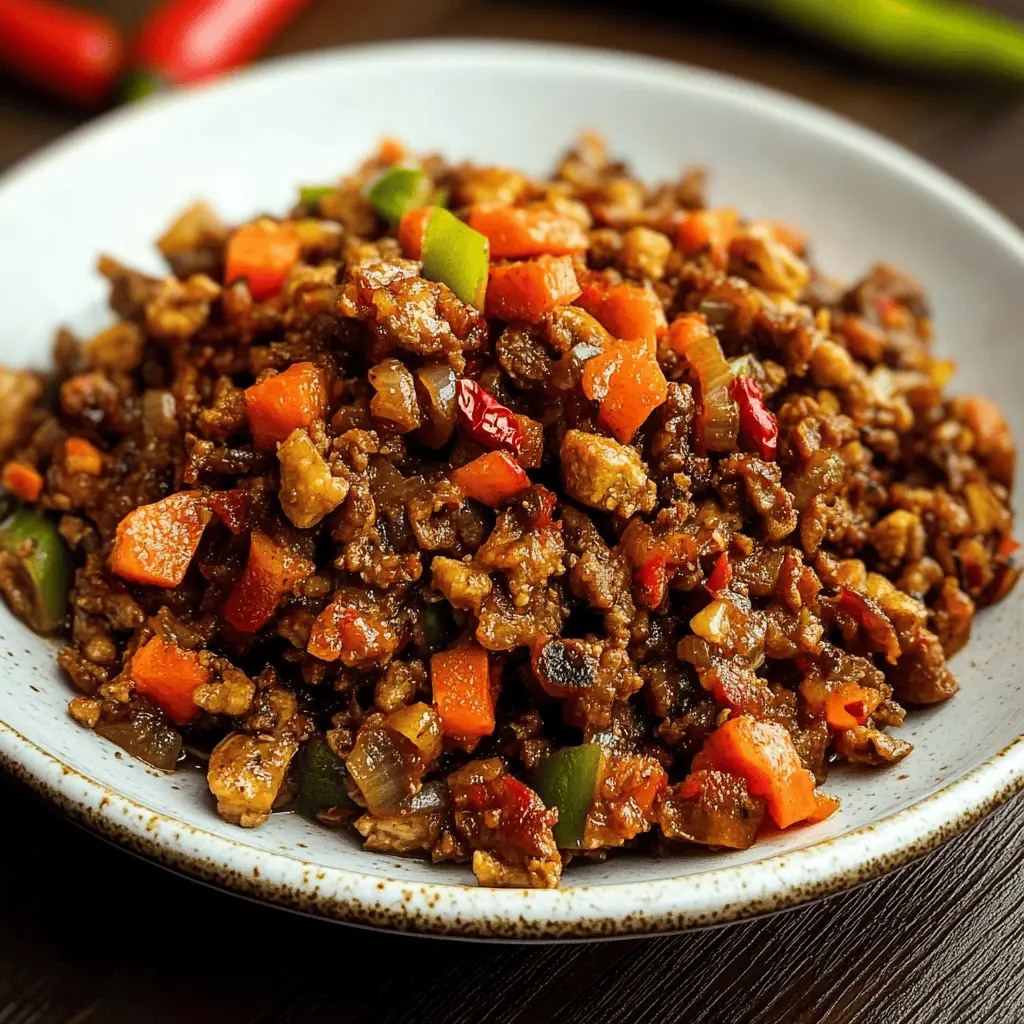
Why You'll Love This Recipe
- Authentic Kapampangan flavors passed down through generations
- Perfect balance of spicy, tangy, and savory notes
- Creates that signature "pulutok" (crackling) sound while cooking
- Rich in nutrients from organ meats
- Versatile as both pulutan (beer match) and ulam (main dish)
- Budget-friendly yet packed with protein
- Better than restaurant versions when made at home
Ingredients
Each component in Bopis plays a vital role in creating its distinctive flavor profile. The organ meats provide a rich, hearty base while vinegar tenderizes them and removes any gamey taste.
Aromatics like onion and garlic build the flavor foundation, while fish sauce adds depth and umami. Bell peppers and carrots contribute sweetness and color to balance the heat from Thai chilies.
Together, these ingredients create the perfect harmony of spicy, tangy, and savory notes that define authentic Bopis.
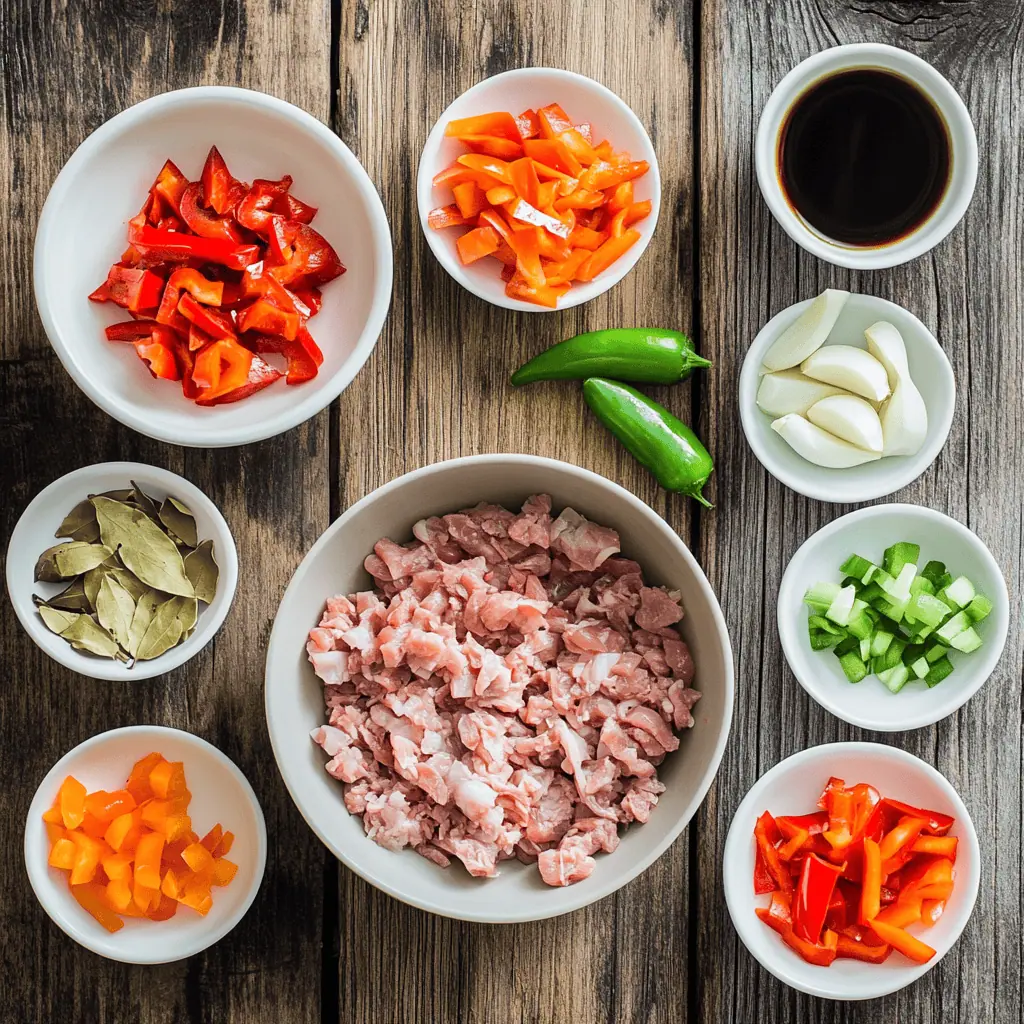
For the Meat Mixture:
- 2 pounds pork lungs, minced finely
- ½ pound pork heart (puso ng baboy), minced finely
- ½ cup Filipino cane vinegar (suka)
- 1 teaspoon salt (asin)
For Sautéing:
- 2 tablespoons canola oil (mantika)
- 1 large white onion, finely chopped (sibuyas)
- 6 cloves garlic, minced (bawang)
- 1 tablespoon fish sauce (patis)
- 2 large carrots, finely diced
- 1 green bell pepper, chopped
- 1 red bell pepper, chopped
- 4-6 Thai chili peppers, chopped (siling labuyo)
Equipment
- Heavy-bottomed pan or cast iron skillet (kawali): Provides even heat distribution for the signature "pulutok" effect and crispy texture. The heavy bottom prevents burning and sticking.
- Sharp chef's knife: Essential for mincing organ meats finely and uniformly.
- Cutting board: Preferably wooden, with a groove to catch juices when mincing meats.
- Mixing bowls: For marinating meats and preparing ingredients.
- Measuring cups and spoons: For precise portioning of ingredients.
- Wooden spoon or heat-resistant spatula: For stirring without damaging the pan or the meat texture.
- Meat thermometer: To ensure safe cooking temperatures when working with organ meats.
- Sizzling plate (optional): For authentic presentation if serving as pulutan.
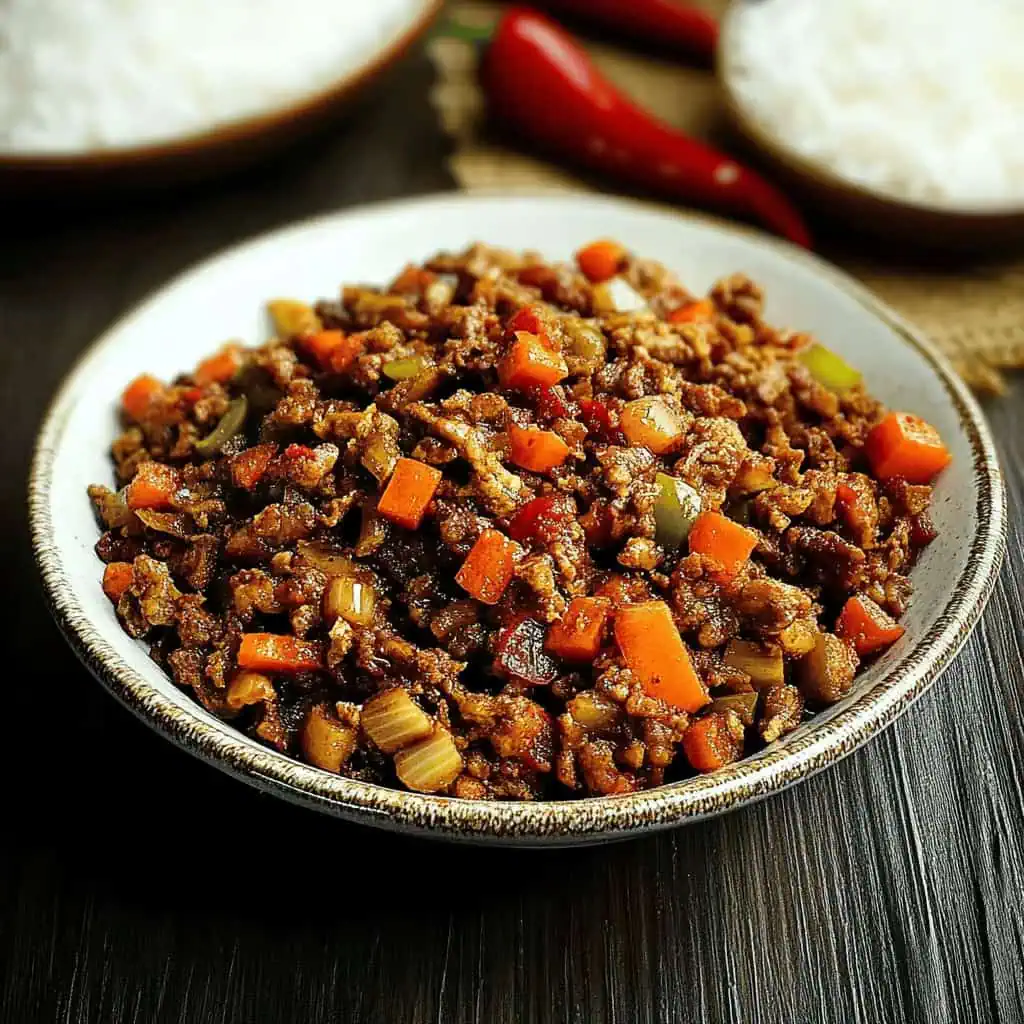
How To Make
- Prepare the Organ Meats:
- Thoroughly clean the pork lungs and heart under cold running water.
- Pat them completely dry with paper towels.
- Using a sharp knife, mince both organs very finely (tinadtad) – each piece should be no larger than ¼ inch. This fine mincing is crucial for achieving the authentic texture.
- Marinate the Meat:
- Place the minced organs in a bowl.
- Add the vinegar (suka) and salt (asin).
- Mix thoroughly and let marinate for 20 minutes at room temperature. This step helps remove any gamey smell (lansa) from the meat.
- Prepare the Vegetables:
- While the meat marinates, finely dice the white onion (sibuyas).
- Mince the garlic (bawang).
- Cut the carrots into small, uniform cubes (about ¼ inch).
- Chop the green and red bell peppers (siling pangsigang) into small pieces.
- Finely chop the Thai chili peppers (siling labuyo).
- Start the Cooking Process:
- Heat a heavy-bottom pan or cast iron skillet (kawali) over medium-high heat (180°C/350°F).
- Add cooking oil (mantika) and wait until it begins to shimmer.
- Add the diced onions and cook for 5 minutes, stirring occasionally until they become translucent (malinaw).
- Add the minced garlic and cook for 2 minutes more until fragrant.
- Cook the Meat Mixture:
- Add the marinated meat mixture to the pan.
- Cook at medium heat (160°C/320°F) for 20-25 minutes, stirring occasionally (haluin paminsan-minsan) to prevent the meat from sticking to the bottom.
- The liquid will gradually reduce during this time.
- As the liquid reduces, you'll notice the meat starting to brown. Continue cooking until you hear the signature crackling sound (pulutok).
- This crackling stage is crucial and indicates the dish is developing its characteristic texture. The oil will begin to separate and form small orange droplets.
- Add the Vegetables:
- Once you hear the consistent pulutok sound, add the carrots first and cook for 3 minutes.
- Then add both the bell peppers and Thai chilies.
- Cook everything together at medium heat (160°C/320°F) until the vegetables are tender-crisp, about 3-5 minutes more.
- Final Seasoning:
- Taste and adjust the seasoning with additional fish sauce (patis) and vinegar if needed.
- The final dish should have a perfect balance of spicy and tangy flavors, with slightly crispy edges while remaining tender in the center.
- Serving:
- If serving as pulutan, transfer to a sizzling plate and serve immediately with ice-cold beer and spiced vinegar (sawsawang suka) on the side.
- If serving as a main dish, plate with steaming white rice (mainit na kanin) and garnish with fresh tomato and onion ensalada.

Tips from Lola's Kitchen
- Use a mixture of native vinegar and cane vinegar for more complex flavor
- Chop all ingredients uniformly for even cooking
- Don't rush the cooking process - the meat needs time to develop flavor
- Listen for the characteristic "pulutok" sound as the meat crisps - this is your cue that it's developing properly
- The finer you mince the meat, the better the texture will be
- Allow the vinegar to mostly evaporate before adding vegetables
- For best results, use a well-seasoned cast-iron skillet or kawali
- Cook at medium heat to allow flavors to develop properly
- The dish should have a slightly oily finish - this carries the flavor
Substitutions
- Organ Meats: If pork lungs are unavailable, increase the amount of pork heart. You can also substitute with a combination of pork liver and pork shoulder for a milder flavor.
- Vinegar: Traditional recipes call for Filipino cane vinegar (sukang Iloko), but you can substitute with apple cider vinegar or white wine vinegar (use 25% less and adjust to taste).
- Chilies: Thai chilies (siling labuyo) provide authentic heat, but you can substitute with bird's eye chilies, serrano peppers, or jalapeños based on your heat preference.
- Fish Sauce: If fish sauce (patis) is unavailable, use light soy sauce with a pinch of salt, though the flavor profile will be slightly different.
- Vegetables: The traditional recipe uses bell peppers and carrots, but you can add diced potatoes, green peas, or chopped string beans for variation.
- Oil: While canola oil is specified, any neutral cooking oil like vegetable oil or rice bran oil works well. Some traditional cooks prefer lard for authentic flavor.
Troubleshooting
- Too Dry: Add 2-3 tablespoons of water or chicken stock and reduce heat to 150°C/300°F. Cover briefly to allow moisture to reintegrate.
- Too Wet/Soupy: Increase heat to 190°C/375°F and continue cooking uncovered until excess liquid evaporates. You should eventually hear the pulutok sound.
- Not Crispy: After the liquid has reduced, increase heat for the final 5 minutes of cooking to develop the crispy edges.
- Too Spicy: Add 1 diced potato during cooking to absorb some heat, or serve with extra rice and a cooling side dish like cucumber salad.
- Lacking Flavor: Balance with additional fish sauce, vinegar, and a pinch of sugar to enhance the overall flavor profile.
- Meat Too Tough: Either the pieces were cut too large or the meat was overcooked. Next time, mince more finely and monitor cooking time more carefully.
- Gamey Smell: Marinate the meat longer in vinegar (up to an hour) or briefly blanch the organs in boiling water with lemongrass before mincing.
Storage & Reheating
- Refrigeration: Cool completely before transferring to an airtight container. Bopis will keep in the refrigerator for up to 3 days. The flavor often improves overnight as spices meld.
- Freezing: Portion into freezer-safe containers and freeze for up to 1 month. Thaw overnight in the refrigerator before reheating.
- Reheating Best Practices:
- Heat a skillet with 1-2 teaspoons of oil until hot
- Add the cold bopis and stir-fry until thoroughly heated
- Continue cooking until you hear the "pulutok" sound again
- Add a splash of vinegar in the last minute of reheating to refresh the flavor
- NEVER use a microwave to reheat, as this will make the meat tough and rubbery and destroy the texture
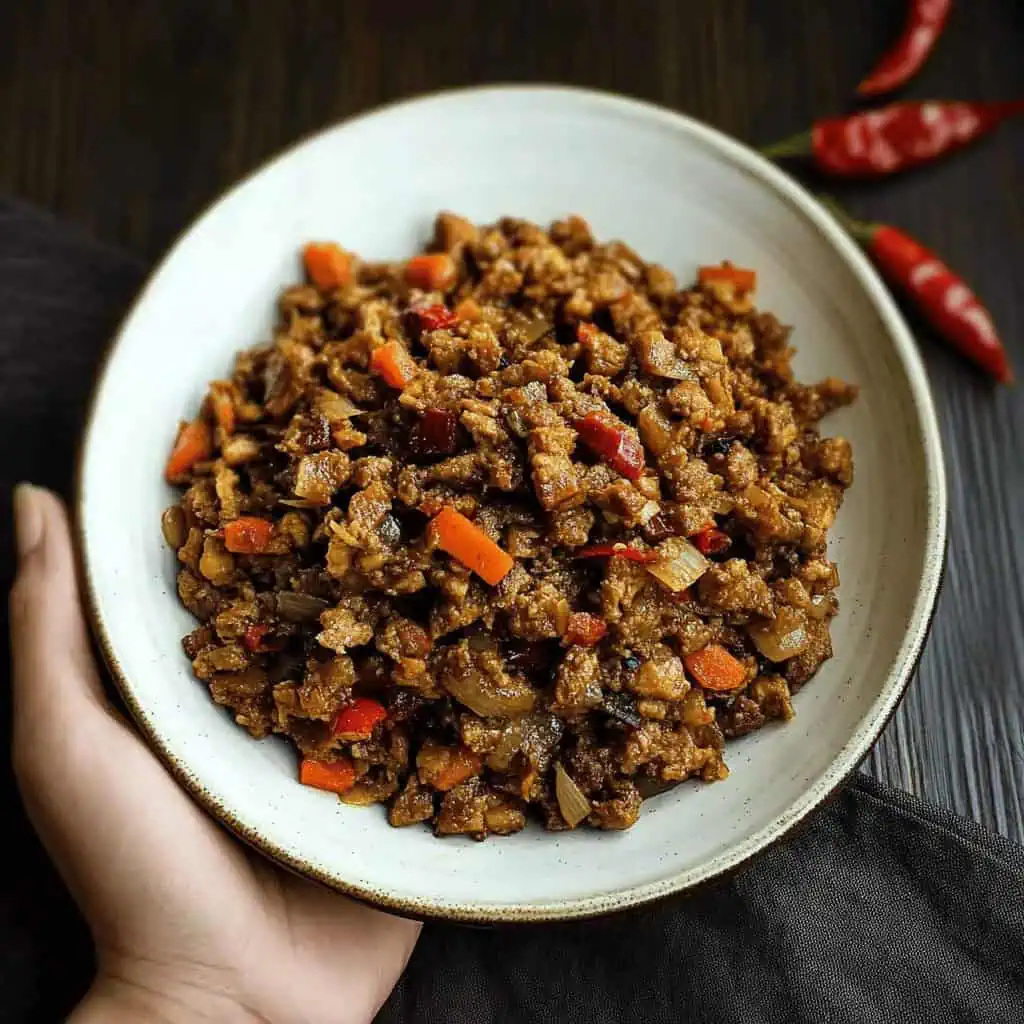
FAQ
Can I use a food processor to mince the meat?
Yes, but use the pulse function carefully to maintain texture control. Avoid over-processing, which can turn the meat mushy. Pulse in short bursts until you achieve the desired consistency - pieces should be uniform but still distinct.
How spicy is traditional bopis?
Authentic Kapampangan bopis is medium to hot, but you can adjust the heat level by varying the amount of Thai chilies. Traditional preparations use enough chilies to provide noticeable heat that balances the tangy vinegar.
Can I make bopis ahead of time for a party?
Yes! In fact, many Filipino cooks believe bopis tastes even better the next day after the flavors have had time to meld. Make it a day ahead, refrigerate, and reheat in a hot skillet until the pulutok sound returns.
What is the best vinegar to use?
For authentic flavor, use Filipino cane vinegar (sukang Iloko or sukang paombong). These have a more complex flavor profile than distilled white vinegar. If unavailable, apple cider vinegar is the best substitute.
Is bopis healthy?
Organ meats are exceptionally nutrient-dense, providing high-quality protein, iron, B-vitamins, and essential minerals. When prepared with moderate oil and served with vegetables, bopis can be part of a nutritious diet.
Where can I source fresh pork organs in the US/Europe?
Visit ethnic markets, especially Filipino, Asian, or Latin American grocery stores. Alternatively, develop a relationship with a local butcher who can special order these cuts for you. Always ensure the organs are fresh and properly handled.
Can I reduce the oil in this recipe?
Yes, though some oil is necessary for the characteristic pulutok effect. Use a non-stick pan and reduce oil to 1 tablespoon if preferred. Note that traditional bopis has a slightly oily finish which carries flavor.
How fine should I mince the meat?
Very fine - pieces should be no larger than ¼ inch. Proper mincing is crucial for the authentic texture and ensures thorough cooking. The finer the mince, the better the texture will be.
How can I tell when bopis is perfectly cooked?
Listen for the signature "pulutok" crackling sound, which indicates that the moisture has evaporated and the meat is crisping at the edges. Visually, you'll notice small orange oil droplets separating from the meat.
Related
Looking for other recipes like this? Try these:
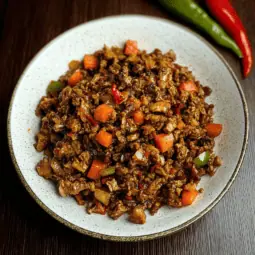
Filipino Bopis (Pulutok)
Ingredients
For the Meat Mixture:
- 2 pounds minced pork lungs baga ng baboy
- ½ pound pork heart minced (puso ng baboy)
- ½ cup vinegar suka
- 1 teaspoon salt asin
For Sautéing:
- 2 tablespoons canola oil mantika
- 1 large onion finely chopped (sibuyas)
- 6 cloves garlic minced (bawang)
- 1 tablespoon fish sauce patis
- 2 large carrots finely diced (karot)
- 1 green bell pepper chopped (berdeng siling pangsigang)
- 1 red bell pepper chopped (pulang siling pangsigang)
- 4-6 Thai chili peppers chopped (siling labuyo)
Instructions
- Start by thoroughly cleaning the pork lungs (baga ng baboy) and heart (puso ng baboy) under cold running water. Pat them dry with paper towels. Using a sharp knife, mince both organs very finely (tinadtad) – each piece should be no larger than ¼ inch. This fine mincing is crucial for achieving the right texture.
- Place the minced organs in a bowl and combine with native vinegar (suka) and salt (asin). Let this mixture marinate for 20 minutes at room temperature. This step helps remove any gamey smell (lansa) from the meat.
- While the meat marinates, prepare your vegetables. Finely dice the white onion (sibuyas) and mince the garlic (bawang). Cut the carrots (karot) into small, uniform cubes. Chop the green and red bell peppers (siling pangsigang) into small pieces. Finely chop the Thai chili peppers (siling labuyo).
- Set a heavy-bottom pan or cast iron skillet (kawali) over medium-high heat (180°C/350°F). Add cooking oil (mantika) and wait until it begins to shimmer. Add the diced onions and cook for 5 minutes, stirring occasionally until they become translucent (malinaw). Add the minced garlic and cook for 2 minutes more until fragrant (mabango).
- Add the marinated meat mixture to the pan. Cook at medium heat (160°C/320°F) for 20-25 minutes, stirring occasionally (haluin paminsan-minsan) to prevent the meat from sticking to the bottom. The liquid will gradually reduce during this time.
- As the liquid reduces, you'll notice the meat starting to brown. Continue cooking until you hear the signature crackling sound (pulutok). This is a crucial stage that indicates the dish is developing its characteristic texture. The oil will begin to separate and form small orange droplets.
- Once you hear the consistent pulutok sound, add the carrots first and cook for 3 minutes. Then add both the bell peppers and Thai chilies. Cook everything together at medium heat (160°C/320°F) until the vegetables are tender-crisp, about 3-5 minutes more.
- Taste and adjust the seasoning with additional fish sauce (patis) and vinegar if needed. The final dish should have a perfect balance of spicy and tangy flavors, with slightly crispy edges (magaspang) while remaining tender (malambot) in the center.
- If serving as pulutan, transfer to a sizzling plate and serve immediately with ice-cold beer and spiced vinegar (sawsawang suka) on the side. If serving as a main dish, plate with steaming white rice (mainit na kanin) and garnish with fresh tomato and onion ensalada.
- For storing, let the bopis cool completely before transferring to an airtight container. It will keep in the refrigerator for up to 3 days. When reheating, use a pan over medium heat (160°C/320°F) with a small amount of oil until you hear the pulutok sound again. Never use a microwave, as this will make the meat tough and rubbery.
- If your bopis becomes too dry (masyadong tuyo) during cooking, add 2-3 tablespoons of water or stock and reduce heat to 150°C/300°F. If it's too wet (masyadong malabnaw), increase heat to 190°C/375°F and continue cooking until the excess liquid evaporates and you achieve the desired consistency.
Tips from Lola's Kitchen
- Use a mixture of native vinegar and cane vinegar for complex flavor
- Chop ingredients uniformly for even cooking
- Don't rush the cooking process - the meat needs time to develop flavor
- Look for the characteristic "pulutok" sound as the meat crisps
- For best results, use a cast-iron skillet or kawali
Nutrition
The Story Behind Bopis (Pulutok)
Growing up in the culinary capital of the Philippines, I learned that every Kapampangan dish tells a story, and bopis is no exception. This beloved pulutan (beer match) and rice topping traces its roots to the resourceful kitchens of Pampanga, where our ancestors transformed humble organ meats into what would become one of the region's most celebrated dishes.
Like many Filipino heritage recipes, bopis emerged from our culture's "zero-waste" cooking philosophy. In the days before refrigeration, when families would butcher pigs for fiestas, skilled home cooks developed ingenious ways to use every part of the animal. The combination of vinegar and chilies wasn't just for flavor – it was a time-tested preservation method that kept the dish safe to eat in our tropical climate while creating that distinctive spicy-tangy profile we've come to love.
The name "pulutok" comes from the characteristic crackling sound the dish makes when it's perfectly cooked – a sound that's music to any Filipino cook's ears. This sizzling symphony happens when the finely minced organs reach just the right temperature, creating that coveted texture where the edges are slightly crispy while the inside remains tender and juicy. Ask any Kapampangan, and they'll tell you: if your bopis isn't making that "pulutok" sound, it's not done yet.
Today, from the bustling carinderias of Angeles to the heritage restaurants of Balanga, bopis has evolved from a practical way to use organ meats into a sought-after delicacy. Each region adds its own twist – some adding coconut milk for richness, others increasing the heat with extra chilies – but the heart of the dish remains the same: a testament to Filipino culinary ingenuity and our ability to turn simple ingredients into something extraordinary.
What makes this dish truly special isn't just its bold flavors or its waste-not-want-not origins – it's how it brings people together. Whether it's served at a local ihawan joint with ice-cold beer or presented as a proud family recipe at Sunday lunch, bopis has a way of turning meals into memories. It's the kind of dish that sparks stories, from uncles debating the perfect spice level to grandmothers sharing their secret techniques for achieving that perfect "pulutok."
Remember: Great bopis isn't just about chopping organs finely—it's about achieving that perfect balance of heat and tang, where each spoonful delivers a flavor explosion that keeps you coming back for more, especially with an ice-cold beer on the side.
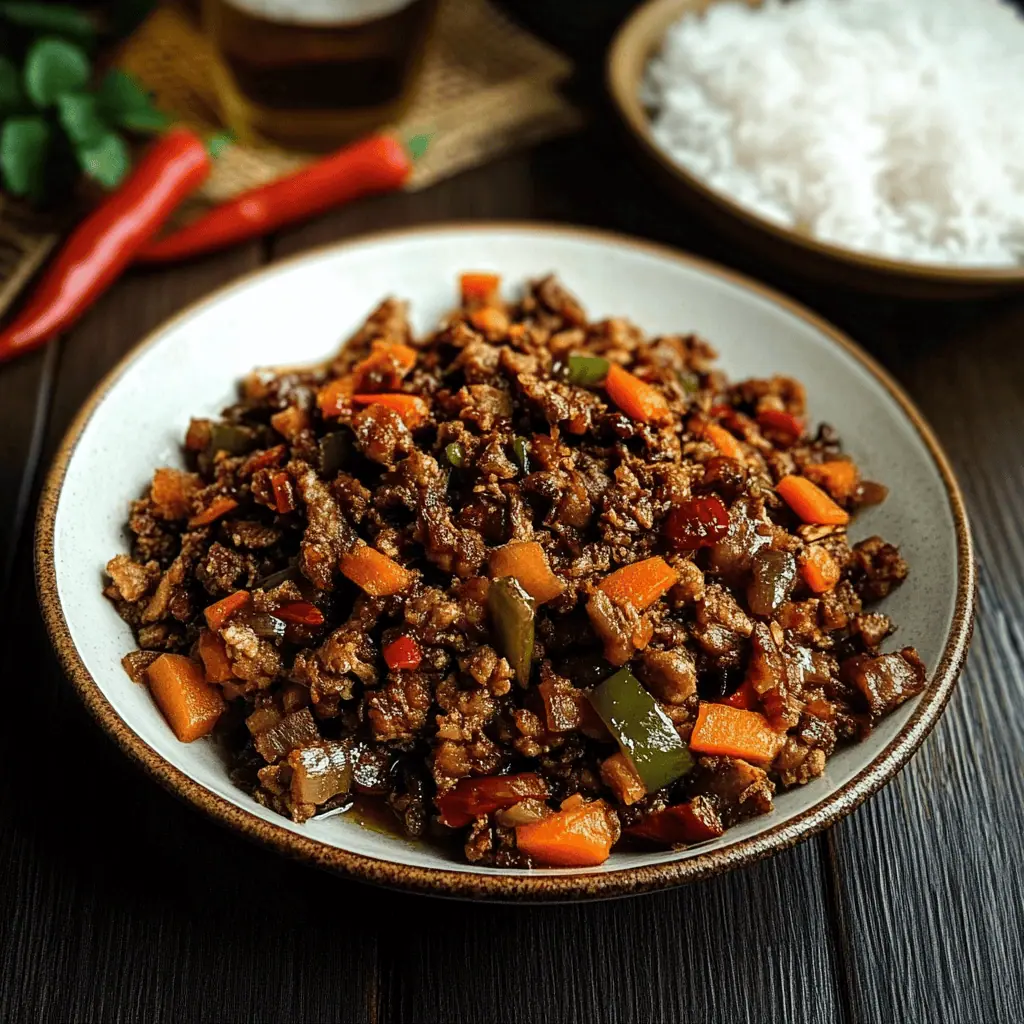









Comments
No Comments